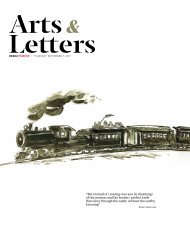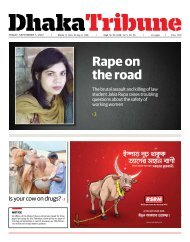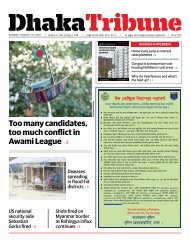Weekend-5-14
You also want an ePaper? Increase the reach of your titles
YUMPU automatically turns print PDFs into web optimized ePapers that Google loves.
Dhaka Tribune<br />
vol 5 Issue <strong>14</strong> | friDAY, jUly 28, 2017<br />
12 Animal<br />
abuse<br />
15<br />
Energy vs<br />
ecology<br />
20 Digital<br />
destiny
CONTENTS<br />
Volume 5 | Issue <strong>14</strong> | July 28, 2017<br />
Editor<br />
Zafar Sobhan<br />
Features Editor<br />
Sabrina Fatma Ahmad<br />
Magazine Editor<br />
Farina Noireet<br />
Deputy Magazine Editors<br />
Khan N Moushumi<br />
Shuprova Tasneem<br />
<strong>Weekend</strong> Tribune Team<br />
Saudia Afrin<br />
Mahmood Hossain<br />
Moumita Ahmed<br />
Tasfia Huda<br />
Baizid Haque Joarder<br />
Saqib Sarker<br />
Mahmood Sadi<br />
Sabiha Akond Rupa<br />
Editor’s note<br />
Dear Readers,<br />
In our constant effort to bring our<br />
readers current issues that warrant<br />
discussion and awareness, this week,<br />
we talk about issues concerning<br />
animal rights, technology and the<br />
environment.<br />
The International Day for the<br />
Conservation of the Mangrove<br />
Ecosystem was July 26, and it is only<br />
apt that we talk about the current<br />
plight of the Sundarbans and the<br />
environmental concerns surrounding<br />
the implementation of the Rampal<br />
coal power plant.<br />
In keeping with the theme of<br />
highlighting global concerns, we also<br />
have an in-depth article on animal<br />
rights, environment and sustainable<br />
development.<br />
On a lighter and sweeter note, our<br />
cooking section this week includes<br />
two decadent desserts featuring the<br />
most delicious of duos – chocolate<br />
and peanut butter.<br />
Finally, we end with an article<br />
that talks about what we have in<br />
store for us as we enter the age of<br />
technological utopia.<br />
Wishing our readers a pleasant<br />
weekend.<br />
Farina Noireet<br />
Contributors<br />
Nazneen Ahmed<br />
Jishnu Brahmaputra<br />
Nimra Naeem<br />
Farzana Romine<br />
Cartoons<br />
Syed Rashad Imam Tanmoy<br />
Priyo<br />
Graphics<br />
Md Mahbub Alam<br />
Alamgir Hossain<br />
Shahadat Hossain<br />
Colour Specialist<br />
Shekhar Mondal<br />
Advertisement<br />
Shahin Ahsan<br />
Production<br />
Masum Billah<br />
Circulation<br />
Masud Kabir Pavel<br />
Website<br />
dhakatribune.com/weekend<br />
facebook.com/<strong>Weekend</strong>Trib<br />
Email your letters to:<br />
weekend@dhakatribune.com<br />
News<br />
2 News<br />
3 Meanwhile<br />
Features<br />
4 Tailored | Men’s fashion<br />
5 Event | Art <strong>Weekend</strong><br />
8 Tech | Google Pixel 2<br />
9 Gaming | Retrospective<br />
12 Spotlight | Animal abuse<br />
15 Environment | Energy vs ecology<br />
16 Gender debate | Science<br />
17 Innovation | Into space<br />
19 Energy | Environmental costs<br />
20 Future | Digital destiny<br />
Regulars<br />
18 Stay in<br />
On the cover<br />
Roots of the mangrove<br />
tree. The Sundarbans.<br />
Photo: Syed Zakir Hossain<br />
WEEKEND TRIBUNE | FRIDAY, JULY 28, 2017<br />
1
News | world at a glance This week<br />
Global ransomware attacks on<br />
the rise: Europol<br />
Global ransomware attacks soared by over<br />
11 percent in the 12 months to March,<br />
Europol reported last Tuesday, but specialist<br />
tools developed with its partners had helped<br />
unlock some 28,000 encrypted devices.<br />
“Ransomware has soared since 2012,<br />
with criminals lured by the promise of profit<br />
and ease of implementation,” the European<br />
police agency said in a statement.<br />
According to a report by cybersecurity<br />
specialists Kaspersky Lab, the “total number<br />
of users who encountered ransomware<br />
between April 2016 and March 2017 rose by<br />
11.4 percent compared to the previous 12<br />
months, from 2,315,931 to 2,581,026 users<br />
around the world”.<br />
Europol and Kaspersky joined forces with<br />
the Dutch police and others a year ago to<br />
EU to threaten consequences if<br />
Poland starts firing judges<br />
The EU’s executive<br />
will on Wednesday,<br />
last week threaten<br />
Poland with rapid<br />
legal consequences<br />
if it begins<br />
dismissing judges<br />
under powers<br />
created in a judicial reform.<br />
Polish President Andrzej Duda on last<br />
Tuesday ratified a bill giving the justice<br />
minister the power to hire and fire the<br />
senior judges who head ordinary courts<br />
as part of the Law and Justice (PiS) party’s<br />
flagship policy.<br />
The nationalist, eurosceptic PiS says the<br />
powers are needed to streamline a slow<br />
and outdated legal system and make judges<br />
more accountable to the people.<br />
Greece returns to debt markets<br />
after three-year hiatus<br />
Greece returned to the debt markets for<br />
the first time in three years on last Tuesday,<br />
with reports saying it was on track to raise<br />
funds at a lower cost, marking a symbolic<br />
victory for the beleaguered eurozone nation.<br />
Initial transactions for the five-year<br />
government bonds put the yield -- the<br />
financing cost for the government or the<br />
rate of return for investors -- at 4.875<br />
percent.<br />
That is slightly below the 4.95 percent in<br />
Greece’s last auction of five-year bonds in<br />
20<strong>14</strong>, which was reportedly the target the<br />
establish the<br />
“No More<br />
Ransom”<br />
initiative,<br />
just months<br />
before a<br />
couple of<br />
high-profile cyberattacks made headlines.<br />
In May the WannaCry attack claimed<br />
more than 300,000 business victims across<br />
150 countries in its first few days, Europol<br />
said.<br />
The attack, using a type of malware that<br />
encrypts files on an infected computer and<br />
demands money to unlock them, crippled<br />
“critical infrastructure and businesses,”<br />
Europol said.<br />
Photo: AFP<br />
Critics say they will damage the<br />
independence of the judiciary, which is<br />
enshrined in the Polish constitution. They<br />
point to other PiS measures to increase<br />
government control over prosecutors, state<br />
media and the Constitutional Tribunal.<br />
The European Commission has already<br />
mounted an unprecedented review of<br />
the rule of law in Poland. The prospect of<br />
politicians firing and replacing judges has<br />
now prompted it to come close to triggering<br />
an “Article 7” censure process.<br />
Article 7 is designed to punish a member<br />
state that refuses to respect the bloc’s<br />
common law and values. The Commission<br />
argues that this covers not providing citizens<br />
with access to a court that is independent of<br />
politicians.<br />
Photo: AFP<br />
Greek government had<br />
set.<br />
Greece currently has<br />
no need to draw money<br />
from the bond markets,<br />
as it recently received<br />
renewed support under<br />
its international bailout that should take it<br />
into next year.<br />
However it is a psychological milestone,<br />
demonstrating that Greece is back on the<br />
road to weaning itself off bailout aid.<br />
Photo: AFP<br />
Local<br />
DU to cancel<br />
routes if<br />
buses are<br />
found<br />
driving on<br />
the wrong<br />
side<br />
The Dhaka University authorities will<br />
suspend bus routes if any buses are<br />
found running on the wrong side<br />
of the road, in violation of traffic<br />
regulations.<br />
The decision was made during a<br />
recent internal university meeting,<br />
according to DU acting proctor AM<br />
Amzad.<br />
Amzad said: “We have instructed<br />
the university’s transport section<br />
to strictly follow traffic rules. If any<br />
transport is found to be disobeying<br />
the decision, action will be taken<br />
and the route will be temporarily<br />
suspended.”<br />
“The DU authorites can’t stop a<br />
route permanently, as thousands of<br />
students are relying on the university<br />
buses for transportation,” he added.<br />
When asked about claims by bus<br />
drivers that students pressure them<br />
into travelling on the wrong way, Prof<br />
Amzad said the drivers had been<br />
told not to heed the students’ “illegal<br />
demands” and to follow traffic rules.<br />
The acting proctor further said that<br />
DU authorities would stay in contact<br />
with traffic sergeants to ensure the<br />
correct routes were maintained.<br />
Student reaction to the decision<br />
has been mixed, with some claiming<br />
that following proper traffic rules<br />
would make it impossible to attend<br />
classes and examinations on time.<br />
Around 80 buses, including both<br />
single and double-deckers, ply 21<br />
routes in Dhaka to pick up students<br />
of DU.<br />
News: Dhaka Tribune<br />
2<br />
WEEKEND TRIBUNE | FRIDAY, JULY 28, 2017
. . . Meanwhile<br />
Cat in the act. Dhalpur, Dhaka. Photo: Mahmud Hossain Opu<br />
Say what<br />
Florida drug dealer arrested after calling<br />
police to report his cocaine stolen<br />
A self-proclaimed drug dealer has been<br />
arrested after he called police to say his<br />
cocaine stash had been stolen in a burglary.<br />
David Blackmon, 35, reportedly told<br />
officers a thief had broken into his car and<br />
stolen not only $50 (£39) in cash, but also a<br />
quarter of an ounce of cocaine.<br />
He described himself as a drug dealer,<br />
police said in a Facebook post, and officers<br />
from Okaloosa County sheriff’s office, in<br />
Florida, found another bag of cocaine and a<br />
rock of crack inside his car.<br />
They also found a crack pipe, the post<br />
said.<br />
According to one officer’s report,<br />
“Blackmon asked [that] if I knew the cocaine<br />
was there, why did I let him keep talking”.<br />
Following his arrest on Sunday, Mr<br />
Blackmon, of Carson Drive, Walton Beach,<br />
was charged with resisting arrest without<br />
violence, cocaine possession and possessing<br />
Photo<br />
of<br />
the week<br />
drug paraphernalia.<br />
He is awaiting a court hearing, according<br />
to the website of the Okaloosa Department<br />
of Corrections.•<br />
News and photo: The Independent<br />
Aries (Mar21-Apr19): Cultural activities could<br />
inspire you this week. If you visit an exhibition<br />
or concert, you might get ideas you can apply<br />
to your own art or craft.<br />
Taurus (Apr20-May20): You could<br />
experience delays with financial matters<br />
at the start of the week, but this phase is<br />
temporary. Things should be back to normal<br />
within a few days.<br />
Gemini (May21-June20): The focus on your<br />
sector of communication could inspire you<br />
to share your message with the world. The<br />
coming week is a great chance to make new<br />
connections that might help you accomplish<br />
your goal.<br />
Cancer (June21-Jul22): Your financial picture<br />
looks fairly dynamic this week. You might<br />
be inspired to follow a plan that helps you<br />
increase your income, whether that means<br />
finding a new job, starting a business, or<br />
asking for a raise.<br />
Leo (Jul23-Aug22): This week could see you<br />
taking dynamic action in the direction of your<br />
dreams and enjoying the process immensely.<br />
Later this week, these can be an opportunity<br />
to get organised.<br />
Virgo (Aug23-Sep22): Seeing things in<br />
perspective and considering your priorities<br />
can be very helpful in planning future goals.<br />
This is also a good time to clear out any<br />
emotional baggage that might be holding you<br />
back.<br />
Libra (Sep23-Oct22): Your social scene looks<br />
particularly lively this week, with plenty to<br />
keep you busy. You’ll very much enjoy mixing<br />
and mingling with friends and meeting new<br />
people.<br />
Scorpio (Oct23-Nov21): You could find<br />
yourself in the spotlight this week. You could<br />
be encouraged to showcase your skills and<br />
let others know what you can do.<br />
Sagittarius (Nov22-Dec21): f you haven’t<br />
been away in a while, the coming days could<br />
see you booking a vacation, or heading out<br />
for a trip. This is the time to embrace fresh<br />
opportunities.<br />
Capricorn (Dec22-Jan19): Your attention may<br />
be drawn to financial matters and how you can<br />
make your money work harder for you. You<br />
could also be aware of deeper currents that<br />
encourage you to work through issues that<br />
have been on the back burner for some time.<br />
Aquarius (Jan20-Feb18): Relationships of<br />
all kinds could rise to the top of your list of<br />
priorities as a powerful focus in your sector of<br />
relating encourages greater interaction.<br />
Pisces (Feb19-Mar20): The key to feeling good<br />
may lie in taking a closer look at your everyday<br />
routines and doing away with those that no<br />
longer work for you. activities that you love to<br />
do can make a positive difference. •<br />
horoscopes<br />
WEEKEND TRIBUNE | FRIDAY, JULY 28, 2017 3
tailored | men’s fashion<br />
Pool party<br />
Wait for that weekend when it’s not raining and you can pull off this<br />
go-to outfit<br />
Mahmood Hossain<br />
Spending quality time in the bathroom, while you’re tapping and swiping away on Snapchat, you’ll yearn for the sun to come back into the<br />
picture. So many celebs and even your friends are out and about abroad, hitting up beaches during the summer. When you’re not pining for<br />
that sunshine and find yourself away from the monsoon, you’ll feel right at home with this incredibly comfortable look.<br />
Top<br />
Cotton-twill or linen, full-sleeve shirt is<br />
our pick for the only layer resting on your<br />
shoulders. A shirt of this style in a blue hue<br />
keeps in line with the seaside theme. The<br />
stylistic approach is in your ability to roll up<br />
your sleeves and have the top two buttons<br />
unbuttoned. The modern day cut also allows<br />
for a more flattering and relaxed collar<br />
design. While a fitted shirt works in all other<br />
cases, this isn’t one of them. Keep in mind,<br />
it’s about feeling comfy and relaxed.<br />
Middle<br />
Keep the<br />
rain away<br />
and feel<br />
free to wear<br />
white. Be it<br />
in pristine<br />
white or offwhite,<br />
fitted<br />
shorts are<br />
in favour for<br />
the current<br />
season.<br />
The obvious is to keep these shorts’<br />
appearances rare. The last thing you want<br />
is a very worn out white pair of shorts. They<br />
have to look ironed or straight out of the<br />
store almost every time you decide to wear<br />
them. And as for length, the hemline of<br />
your shorts should drop right above your<br />
knees. Whether you decide to tuck or untuck<br />
your shirt into your shorts is up to you. But<br />
be sure of one thing, just like bespoke or<br />
tailored suits nowadays, belts are absolutely<br />
unnecessary. If the shorts fit, no need for<br />
belts. Simple.<br />
Somewhere in between<br />
A little jewellery never hurt anyone. Nothing<br />
sounds more like an Italian summer<br />
day like this look, added with quality<br />
bracelets. Woven leather bracelets are<br />
the preferred wrist wear nowadays, even<br />
more than wristwatches. A contrasting<br />
and complimenting colour scheme works<br />
wonderfully in an outfit like this one. The<br />
best accessory with all those characteristics<br />
can be found in a well-made bracelet.<br />
You can either sport one bracelet in thick<br />
materials, or two thinner bracelets together<br />
on one wrist.<br />
Bottom<br />
Sticking with the light and breezy look for<br />
a weekend by the water, a beautiful pair<br />
of white loafers are in order. You can play<br />
around a little when it comes to options,<br />
even sport suede if you like. If it’s sunny,<br />
don’t be shy to rock the suede. Driving<br />
shoes round off the look we’re looking<br />
for here. However, opting out of these<br />
for light coloured loafers without laces<br />
can work too. With your sleeves rolled up,<br />
fitted white shorts and sockless feet inside<br />
driving shoes, your hours under the sun will<br />
become a bit more enjoyable. •<br />
4<br />
WEEKEND TRIBUNE | FRIDAY, JULY 28, 2017
Event | Art <strong>Weekend</strong><br />
More than words<br />
The third annual Art <strong>Weekend</strong> reviewed<br />
Sabrina Fatma Ahmad<br />
With two fairly successful events covered, the Art <strong>Weekend</strong>, a two day art exhibition hosted<br />
by a number of embassies in Dhaka at the residences of the respective ambassadors, was<br />
an event <strong>Weekend</strong> Tribune was eagerly looking forward to attending. Hosting this year’s<br />
AW (held July 21-22) were the German Embassy, the Embassy of Denmark, and the Royal<br />
Norwegian Embassy.<br />
“There has never been a more important<br />
time for an event like this” said German<br />
Ambassador Dr Thomas Prinz, towering over<br />
this writer’s not inconsiderable height as he<br />
alluded to last year’s Gulshan attack. “There<br />
are people who will try to scare you, tell you<br />
“don’t do this, don’t go out, live in fear. How<br />
do you stand up to them? You continue to<br />
live your life, to make and enjoy art.”<br />
Adorning the white walls of his residence<br />
were photographs by Shamim Shorif Susom,<br />
a young aviator and photographer, whose<br />
stunning aerial shots of rural Bangladesh<br />
resemble abstract paintings, bursting with<br />
life and colour.<br />
The Norwegian ambassador’s place is just<br />
a hop, skip and jump away, and housed an<br />
impressive collection of artwork rendered<br />
by 13 students from the Fine Arts Institute<br />
of the Khulna University. From sculptures<br />
to lithographs to mixed media paintings,<br />
all of the pieces were inspired by famed<br />
Norwegian author and freedom of speech<br />
advocate Henrik Ibsen.<br />
“Ibsen’s messages remain relevant<br />
today, even in our context” said Abu Kalam<br />
Shamsuddin, one of the participating<br />
Photo: Embassy of Denmark<br />
Photo: Embassy of Denmark<br />
artists. When asked about the most<br />
memorable aspect of his group’s journey<br />
from Khulna University to the ambassador’s<br />
house in Dhaka, he laughed and replied<br />
“Transporting all the artwork – particularly<br />
the sculptures. We had our hands on our<br />
hearts half the time.”<br />
A rainy rickshaw ride away, the mood was<br />
a festive one at the Danish ambassador’s<br />
house. On the walls hung vibrant<br />
watercolour paintings by indigenous artists<br />
Lumbiny Dewan, Nomosta Rema and Shudip<br />
Chakma. The ambassador’s beautiful wife<br />
Ratanawadee Hemniti Winther welcomed<br />
all visitors with a gracious smile. On<br />
special display racks, diaphanous dresses<br />
Photo: Royal Norwegian Embassy<br />
in delicate muslins rendered by designer<br />
Maria Sultana Mumu, and in one corner,<br />
the Ambassador’s collection of guitars. “I<br />
just put them up there too, because I like<br />
music, and I’m entertaining everyone at<br />
my gallery today,” said Ambassador Mikael<br />
Hemniti Winther, with a smile. Sobering<br />
up, he continued “Considering the unrest<br />
and landslides happening down in the CHT,<br />
it’s been a terrible year for the indigenous<br />
community, coming after several terrible<br />
years. It’s important to listen to them, to give<br />
them a voice, and art is a good way to start<br />
that conversation.”<br />
From fashion to freedom of speech, from<br />
aerial photographs to beautiful watercolour<br />
paintings, this year’s Art <strong>Weekend</strong> was a<br />
treat to the senses, and provided plenty of<br />
food for thought. •<br />
Photo: German Embassy<br />
Photo: Embassy of Denmark<br />
WEEKEND TRIBUNE | FRIDAY, JULY 28, 2017 5
Cook your own way | Kitchen chronicles<br />
the Blondie and the brownie<br />
Farzana Romine<br />
If you like peanut butter like me, then you will love these two recipes. The basic difference between blondie and brownie is that one is made<br />
with rich dark chocolate and the other is mainly vanilla or white chocolate, or in this case peanut butter based. Both of these recipes are<br />
simple and easy and you can make them in big batches for big parties. Your guests will love them.<br />
Peanut<br />
butter swirl<br />
brownie<br />
Ingredients:<br />
• 8 tbsp butter<br />
• 1 cup dark chocolate chips<br />
• 2/3 cup all-purpose flour<br />
• 1/2 tsp baking powder<br />
• 1/4 tsp salt<br />
• 3/4 cup granulated sugar<br />
• 3 large eggs<br />
• 2 tsp vanilla extract<br />
For the peanut butter topping:<br />
• 4 tbsp melted butter<br />
• 1/2 cup powdered sugar<br />
• 1 cup peanut butter<br />
• 1/4 tsp salt<br />
Directions:<br />
Preheat oven to 325°F/ 160°C.<br />
1. Line a buttered 8-inch square baking pan<br />
with parchment paper.<br />
2. Put butter and chocolates in a heatproof<br />
medium sized bowl set over a pan of<br />
simmering water; stir until melted. Let it<br />
cool slightly.<br />
3. Mix together flour, baking powder, and<br />
salt in a separate bowl, and set aside.<br />
4. Add granulated sugar into the chocolate<br />
mixture. Add eggs, and whisk until<br />
mixture is smooth. Stir in vanilla, then<br />
add the flour mixture to this. Stir until<br />
well incorporated.<br />
5. For the swirl, stir together butter,<br />
powdered sugar, peanut butter, salt, and<br />
vanilla in a bowl until smooth.<br />
6. Pour one-third of the batter into prepared<br />
pan, and spread evenly. Place dollops<br />
of the peanut butter filling, about one<br />
inch apart on top of the batter. Drizzle<br />
remaining batter on top, and gently<br />
spread to fill pan. Place dollops of<br />
remaining filling on top.<br />
7. With a butter knife, gently swirl filling<br />
into batter, running knife lengthwise and<br />
crosswise through layers. Bake for 45<br />
minutes, until a cake knife inserted into<br />
brownie (avoid centre and edges) comes<br />
out with a few crumbs but is not wet.<br />
8. Leave to cool slightly in the pan, for about<br />
15 minutes. Lift out the brownie; let it<br />
cool completely on a wire rack before<br />
cutting into squares.<br />
6<br />
WEEKEND TRIBUNE | FRIDAY, JULY 28, 2017
Peanut butter<br />
blondie<br />
Ingredients:<br />
• 1 cup brown sugar<br />
• 1 cup smooth or chunky peanut butter<br />
• 1/2 cup butter<br />
• 1 tsp vanilla<br />
• 1 tsp baking powder<br />
• 2 eggs<br />
• pinch of salt<br />
• 1+1/2 cup flour<br />
• 1 cup chocolate chips<br />
Directions:<br />
Preheat your oven to 350°F/175°C.<br />
1. Line a 13X9 inch baking pan with<br />
parchment paper. Butter the sides of the<br />
pan.<br />
2. Beat the butter and sugar together until<br />
light and fluffy. Now add the peanut<br />
butter and beat well. Add the eggs and<br />
vanilla. Beat until smooth.<br />
Photos: Farzana Romine<br />
3. In a bowl, mix the salt, flour and baking<br />
powder. Now add this mixture of dry<br />
ingredients in tothe butter mixture and<br />
stir well, until fully combined. Add the<br />
chocolate chips.<br />
4. Spread this mixture in the baking tin<br />
evenly.<br />
5. Bake for 25 to 30 minutes, until it’s<br />
set and light brown. Allow it to cool<br />
completely in the pan before cutting into<br />
squares and serve.<br />
WEEKEND TRIBUNE | FRIDAY, JULY 28, 2017 7
Tech | Google Pixel 2<br />
Google needs love too<br />
This is what to expect or all we know so far of the upcoming Pixel<br />
Mahmood Hossain<br />
We’ve already discussed to death of what to expect from Apple’s flagships, but now it’s Google’s turn to show off the sequel to the<br />
original Pixel. The Pixel and Pixel XL were huge hits from the point of release so it’s only natural to want more from the next stage of<br />
evolution from a Google smartphone. While the date of release for the new Pixel phones are yet to be confirmed, we can only assume<br />
we’ll see a launch date in October.<br />
All-rounder<br />
The obvious information to take without<br />
diving too deep into speculations, is the<br />
overall improvements to a new phone.<br />
There will be a new camera, improved<br />
chipsets and even have a water-resistant<br />
body. The Pixel 2 will surely impress for a<br />
pure Google Android experience, better<br />
than its predecessor.<br />
Give it a squeeze<br />
One of the many rumours flying around is<br />
how the Pixel 2 might take a page from HTC<br />
U11. The phone might have a squeezable<br />
frame, letting the user take advantage of<br />
the pressure sensitive feature that allows<br />
opening certain apps like the camera app.<br />
Hoping to be a little more customisable,<br />
you’ll be able to launch other apps of your<br />
choice by squeezing your phone.<br />
Big and slim<br />
As usual, concept art and other images are<br />
leaked to the market. The latest images<br />
are of the next Pixel XL. They are basically<br />
renderings of what the new XL may look<br />
like. At first glance, you’ll be able to see<br />
the 6-inch display with thinner bezels. It<br />
looks a tad more rectangular with slightly<br />
sharper corners. There can also be different<br />
coloured variants in red, teal or the original<br />
blue colour of the Pixel.<br />
Ease or hurt the pocket<br />
New gadgets of this calibre usually will cost<br />
more than we’d like. At this moment, you’ll<br />
be able to get the original, unlocked Pixel<br />
for over Tk52,000. This means there will be<br />
a significant price bump upward for a new<br />
flagship. It’s a premium phone, therefore, it<br />
will cost a premium price. But it also sounds<br />
like there will be a more affordable option,<br />
what insiders are calling, in the Pixel 2B. The<br />
specs won’t be as great but it won’t cost you<br />
an arm or a leg either. But look at the bright<br />
side, it’ll cost $300 or $400 less than the<br />
newest iPhone slated to release later this<br />
year.<br />
The brains<br />
The latest software update from Google<br />
is called the Android O. While it’s already<br />
available for developers, the newest Android<br />
update has yet to be rolled to the mass<br />
market. It seems that the new Google Pixel<br />
2 will be the first Android smartphone to<br />
roll out the Android O straight from the<br />
factory. This introduces a factory setting that<br />
will allow users to experience the picturein-picture<br />
apps for multitasking, new app<br />
notifications and improved copy and paste<br />
options.<br />
It won’t be easy for this new version of<br />
the Pixel. They’ll still have to fend off the<br />
Samsung Galaxy S8, OnePlus 5 and the<br />
LG G6. We won’t consider the new Apple<br />
iPhone simply because they are of different<br />
operating systems.<br />
Only time will tell if the new Pixel can<br />
impress us yet again as the premier pure<br />
Android experience on a smartphone. •<br />
8<br />
WEEKEND TRIBUNE | FRIDAY, JULY 28, 2017
Gaming | Retrospective<br />
Top 5 classic video games<br />
Part 2<br />
Jishnu Brahmaputra<br />
1: Cadillacs and Dinosaurs –<br />
Capcom, 1993<br />
The number one spot is taken by the<br />
number one game in the history of<br />
Bangladesh. This is a game that has<br />
less of a cult following and more of an<br />
unofficial national pedestal. This game is<br />
so ridiculously coveted that the names of<br />
Jack Tenrec, Hannah Dundee, Mustapha<br />
Cairo, and Mess O’Bradovich are etched into<br />
the minds of the gaming population of the<br />
country. In fact, it could be said that every<br />
single type of character, move, weaponand<br />
pickup in this game are remembered and<br />
remembered fondly. From the mostlyharmless<br />
punches from Ferris to the flying<br />
kicks from Thug, from Hammer T dropping<br />
a suspiciously undigested doughnut upon<br />
death to Skinner shooting you into a ‘woahawh!’-inducing<br />
death, we all remember it<br />
as if it was yesterday. Everyone has their<br />
legendary stories when it comes to this<br />
game, and an unspoken decree states that<br />
a person reaches an elevated state of being<br />
when they finish the game without dying<br />
(and without exploiting the glitches on some<br />
arcade machines such as unlimited bullets<br />
on guns). Everyone has countless memories<br />
with this side-scrolling beat-em-up which<br />
can be played with up to three players,<br />
and there isn’t a Bangladeshi gamer worth<br />
a dime that hasn’t played this absolute<br />
masterpiece!<br />
As this highly-debatable and probably<br />
infuriating list draws to a close, let us<br />
have an imaginary toast with our mugs of<br />
health pickups. A toast to all the countless<br />
‘unproductive’ hours we have spent on<br />
having some good clean fun at the expense<br />
of nobody’s suffering. Here’s to all the<br />
dropkicks by Mustapha, the overtakes by<br />
Ford Indigos and the BFG blasts; to jumping<br />
on the stone horse to bring it to life, the<br />
Megabombs dropped and the civilians shot<br />
(whoops); pulling off the 24-hit Razor Ramon<br />
Combo, and seeing the expression on your<br />
friend’s face as you rip off his leg and beat<br />
him to death with it while the screen shows<br />
a bloody ‘Fatality’. Here’s to gaming.<br />
2: Need for Speed 2 SE – EA,<br />
1997<br />
Though NFS 3 was a better game overall,<br />
NFS 2 was by far more popular. Don’t let<br />
the previous statement take anything away<br />
from this blindingly fun game, though; it<br />
is every bit as deserving of praise. With a<br />
slew of some of the hottest contemporary<br />
supercars, a reasonably-balanced tier<br />
system for those cars and (mostly) brilliantly<br />
designed tracks, the game provided hours<br />
of unadulterated fun for anyone who<br />
functioned like a normal human being.<br />
3: Doom 2 – ID Software,<br />
1994<br />
The granddaddy of all modern FPS games<br />
– sure, Wolfenstein 3D pioneered the 3D<br />
genre, but it didn’t have elevations or such a<br />
wide variety of weapons, enemies and just<br />
plain fun. ID software’s brainchild was a helland-industrial<br />
themed gold mine for more<br />
mature audiences with lots of gratuitous<br />
gore, scary demons, frighteningly powerful<br />
cyborgs and a riveting soundtrack. Although<br />
I admit that Quake, released a couple of<br />
years later was a far better game in almost<br />
every way, Doom paved the way for Quake<br />
to exist and was exponentially more popular<br />
(to the point of being on school computers,<br />
such was its ubiquity).<br />
4: Prince of Persia 2: The<br />
Shadow and the Flame<br />
– Broderbund<br />
Software, 1993.<br />
This side-scrolling<br />
game about a<br />
Persian-pauperturned-prince<br />
trying<br />
to save his beloved<br />
princess from the<br />
evil Jaffar might seem<br />
simple at first, but its<br />
wide range of puzzles<br />
and riddles make it stand in a<br />
league of its own. Bear in mind that these<br />
were days when internet connections were<br />
extremely rare and walkthroughs for video<br />
games were virtually unheard of. In fact,<br />
some of the puzzles were so difficult and<br />
so few clues were offered that it took some<br />
players outright years to finish the game,<br />
after they abandoned it out of frustration<br />
and a failure to make progress (myself<br />
included). The skeleton on the bridge, the<br />
magic horse and of course, the eponymous<br />
shadow-and-flame business are all etched<br />
into the minds of anyone who has finished<br />
this gem.<br />
5: Raptor: Call of the<br />
shadows – Apogee/Cygnus,<br />
1994<br />
With one of the best soundtracks in the<br />
history of video games, Raptor had great<br />
graphics, fairly scaling (and never annoyingly<br />
unfair) skill levels, truly – and there’s no<br />
other word for it – awesome weapons and<br />
a no-bullshit-kill-or-be-killed storyline (or<br />
lack thereof). Most people think of it as a<br />
very easy game, but trust me; try the Elite<br />
skill level or, for a little challenge, prove that<br />
you’re better than yours truly by starting<br />
in Tango Sector on Elite and finishing the<br />
game without buying ANY phase shields. I<br />
personally do it by playing only five to six<br />
waves of Tango Sector and finishing Outer<br />
Regions without having played a single level<br />
of Bravo (yes, without phase shields). •<br />
WEEKEND TRIBUNE | FRIDAY, JULY 28, 2017 9
10 WEEKEND TRIBUNE | FRIDAY, JULY 28, 2017<br />
Photo Story | Mango Chronicles
Mango madness<br />
Chapai Nawabganj<br />
is considered to be<br />
the mango capital<br />
of Bangladesh.<br />
Covered with<br />
mango orchards,<br />
this summer fruit is<br />
known to actually<br />
sustain the local<br />
economy during<br />
this season. This<br />
week, we bring you<br />
some snapshots<br />
from the wholesale<br />
mango market at<br />
Kansat, Chapai<br />
Nawabganj, as well<br />
as the journey from<br />
orchard to market<br />
from all over the<br />
district, especially<br />
Shibganj, Bholahat<br />
and Gamostapur<br />
upazilas.<br />
<br />
Photos: Noor Ahmed Gelal<br />
WEEKEND TRIBUNE | FRIDAY, JULY 28, 2017 11
spotlight | Animal Abuse<br />
Animal Rights,<br />
Environment<br />
and<br />
Sustainable<br />
Development<br />
Animals throughout the world are in grave trouble<br />
Photo: Bigstock<br />
Nazneen Ahmed<br />
In Bangladesh, Chittagong city went ahead with its dog culling plans, despite a High Court ruling against this practice. There have been<br />
numerous occasions of wild animals, such as Bengal tigers, leopards and fishing cats, being killed by mobs when spotted in human territories.<br />
Deaths have also occurred when authorities failed to provide adequate care or mishandled animals when they were caught.<br />
On the global level, animals suffer in<br />
laboratory experiments, are forced<br />
to perform in circuses and are bred<br />
inhumanely in pet shops. In farms across<br />
China and Vietnam, bears are raised in<br />
‘crush cages’ to extract bile from their<br />
gall bladders for traditional medicine that<br />
have no scientific basis. Open holes are<br />
made in their abdomens and metal tubes<br />
are permanently implanted. The pain is<br />
so unbearable that some bears try to kill<br />
themselves by punching the infected area.<br />
Starved and dehydrated, thousands of bears<br />
suffer this torture for as long as they survive<br />
– around 20 years.<br />
Animals are being trafficked for the illegal<br />
exotic pet trade, traditional medicine, and<br />
unauthorised zoos and farms. In 2016, a<br />
global assessment by the United Nations<br />
Office on Drugs and Crime revealed that<br />
animal trafficking has escalated into<br />
transnational organised crime in which<br />
all regions of the world were more or less<br />
involved, either as a source, transit or<br />
destination country.<br />
The fur industry spread across China,<br />
US and Europe is another sector where<br />
gross animal abuses have been reported.<br />
Crammed in small cages, minks, foxes,<br />
and raccoons are bred in such deplorable<br />
conditions that they become insane and<br />
were found to self-mutilate – biting their<br />
skin and limbs. Their deaths are anything<br />
but humane - they are even skinned alive to<br />
cut down costs.<br />
12<br />
WEEKEND TRIBUNE | FRIDAY, JULY 28, 2017
These are just a few snapshots of the larger<br />
picture. The massive - and underreported<br />
- abuse, exploitation and extinction of nonhuman<br />
animals by our human species pose<br />
serious ethical and philosophical questions.<br />
Now is the time to revisit the moral status<br />
that we have attributed to non-humans and<br />
nature for centuries.<br />
Philosophical origin of<br />
animal rights<br />
While religion has been influential in<br />
determining moral status regarding animals,<br />
it is largely the philosophy of the West that<br />
has shaped the paradigm. Aristotle wrote<br />
that nature existed only for human use and<br />
as animals do not have the power to reason,<br />
they are suitable for exploitation. However,<br />
Pythagoras viewed animals as kindred<br />
souls, promoted a vegetarian lifestyle and<br />
explicitly forbade animal exploitation. In the<br />
East, ancient Jain and Buddhist philosophies<br />
recognised animal suffering and put a<br />
strong emphasis on ahimsa or non-violence<br />
towards all living beings. Confucianism<br />
believed in the oneness of nature and<br />
humans.<br />
Dr Sultan Hafeez Rahman, a reputed<br />
economist associated with founding of the<br />
Chunati Wildlife Sanctuary in Chittagong,<br />
reminds us the root cause of today’s cruelty<br />
to animals: “The 500-year long history of<br />
plundering nature and destroying species<br />
has its roots in the Man versus Nature<br />
paradigm that was born in the modern<br />
era and derived its legitimacy from the<br />
Industrial Revolution.”<br />
The Qur’an makes it clear that animals<br />
are equally important to God as humans<br />
are: There is not an animal on earth, nor<br />
a creature flying on two wings, but they<br />
are communities like you; we have not<br />
ignored anything in the Book and all [living<br />
things] will return to their Lord [Surah Al-<br />
An’am:38]. There are numerous Hadiths<br />
that forbid beating animals, forcing them to<br />
carry excessively heavy loads, slaughtering<br />
animals in front of one another, sharpening<br />
knives in front of sacrificial animals, to<br />
mention a few. A moving account of<br />
kindness to animals is available in Sahih<br />
Bukhari [Vol.4, Book 54, No. 538], where a<br />
sexual worker was pardoned because she<br />
gave water to a thirsty dog.<br />
Animals and environmental<br />
conservation<br />
Sadly, we remain largely unaware of how<br />
our consumption causes suffering and<br />
threatens animals through deforestation,<br />
overhunting, and overfishing. When we<br />
buy foreign breeds of pets instead of<br />
adopting local breeds, we sustain the<br />
farms that breed these animals in horrific<br />
When we are empathetic<br />
for the sufferings of<br />
animals, we change our<br />
behaviour and become<br />
responsible tourists and<br />
consumers<br />
conditions. By buying exotic animals as pets<br />
and purchasing commodities made from<br />
wild animals, we contribute to the illegal<br />
wildlife trade. Irresponsible consumption<br />
also undermines biodiversity conservation<br />
efforts of millions of dollars and leads to<br />
greater negative environmental footprints,<br />
of consumers and manufacturers.<br />
Industrial fishing for tropical tuna and<br />
sharks makes use of unsustainable fishing<br />
gears namely, Fish Aggregating Devices<br />
(FADs) and long-lines. These generate a<br />
large amount of by-catch - unwanted marine<br />
creatures that are caught, die and are<br />
discarded. WWF puts forward a shocking<br />
estimate: around 38 million tonnes or 40<br />
percent of annual global marine catch is bycatch.<br />
Each year, thousands of small whales,<br />
dolphins, endangered loggerhead turtles<br />
and critically endangered leatherback turtles<br />
are killed. This also threatens 26 species of<br />
sea birds, including 17 albatross species,<br />
with extinction.<br />
Such levels of wastage of marine lives are<br />
emptying our oceans, threatening future<br />
revenues and livelihoods and raising serious<br />
questions of sustainability and animal<br />
welfare.<br />
Animals and sustainable<br />
development<br />
Aside from the fact that there is a moral<br />
obligation to refrain from treating animals<br />
with cruelty, why has protecting animal<br />
rights become important in the age of<br />
sustainable development?<br />
Estimates from the Organisation for<br />
Economic Co-operation and Development<br />
(OECD), UNEP and the International Police<br />
Organization (INTERPOL) place the cost of<br />
environmental crime, including illegal wild<br />
animal trade, to be up to USD 258 billion<br />
annually, which is almost twice the amount<br />
of the USD 132 billion of development aid<br />
disbursed globally in 2015. This means that<br />
environmental crime is not only affecting<br />
animals but also stealing revenue streams<br />
from governments of developing nations<br />
and limiting their ability to meet the<br />
Sustainable Development Goals (SDGs).<br />
When we are empathetic for the<br />
sufferings of animals, we change our<br />
behaviour and become responsible tourists<br />
and consumers. By rejecting commodities<br />
that are made from exotic animals or<br />
through ecosystem destruction, boycotting<br />
industries that compromise animal welfare<br />
standards, avoiding entertainment that<br />
exploits animals, we, as consumers, are<br />
well-placed to demand sustainability in<br />
supply chains and thus pave the path for<br />
sustainable development.<br />
WEEKEND TRIBUNE | FRIDAY, JULY 28, 2017 13
egenerate.”<br />
In short, animal rights and welfare,<br />
directly or indirectly, are increasingly being<br />
recognised across the globe.<br />
Capuchin monkey of Peru held captive <br />
There are inspiring examples of industries<br />
and retailers which were forced to limit their<br />
environmental footprint: Mattel, the world’s<br />
largest toy company and manufacturer of<br />
Barbie dolls, the food chain KFC, Nestle´,<br />
Procter and Gamble, Kraft, Danone and<br />
Unilever used to purchase their packaging<br />
paper from the Indonesian paper giant<br />
Asia Pulp and Paper (APP), which collected<br />
pulp by rampant destruction of Indonesian<br />
rainforests. Confronted with worldwide<br />
protests by consumers and environmental<br />
activists, these companies cancelled their<br />
contracts with APP, thus dropping rainforest<br />
deforestation from their supply chains.<br />
Top sportswear and fashion brands, such<br />
as Benetton, Adidas, H&M, Puma, Valentino,<br />
Levi’s, and Marks and Spencer, to name<br />
but a few, have committed to working with<br />
their suppliers in the textile supply chain to<br />
stop discharging hazardous chemicals into<br />
oceans and seas. UK supermarket chain<br />
Tesco and US retailer Walmart are being<br />
forced to remove unsustainably-caught tuna<br />
from their suppliers.<br />
Acknowledging that animal welfare<br />
has ethical, economic, and environmental<br />
implications, the Food and Agricultural<br />
Organisation (FAO) has provided technical<br />
guidelines on a range of animal welfare<br />
issues, such as humane management<br />
of dog population through neutering,<br />
compassionate handling, transport<br />
and slaughter of livestock, emergency<br />
interventions for livestock during natural<br />
disasters.<br />
In the World Conservation Congress in<br />
Photo:Claudia Galvez-Durand Besnard/SERFOR/Mongabay<br />
2016, IUCN member countries expressed<br />
their support for nature’s rights to exist<br />
through their resolution “the rights of<br />
nature as a fundamental and absolute key<br />
element in all IUCN’s areas of intervention<br />
and decision making.” Ecuador has included<br />
nature’s right to exist in its constitution.<br />
Bolivia enacted the Law of the Rights of<br />
Mother Earth, which not only ensures<br />
nature’s right to exist but also guarantees<br />
that nature can take legal action against<br />
its tormentors. France has changed the<br />
legislative status of animals: no longer<br />
termed as ‘objects’, animals have officially<br />
been recognised as “living, sentient beings,”<br />
thereby allowing their sufferings to get<br />
addressed. Admiringly, Bangladesh has also<br />
taken the right step forward by approving<br />
the draft Animal Welfare Act 2016 to punish<br />
animal offenders.<br />
The most landmark recognition of animal<br />
rights can be felt in target 12.8 of the SDG,<br />
which explicitly requires people to adopt<br />
lifestyles that are “in harmony with nature.”<br />
The central aim here is to create a society<br />
that learns to preserve nature and animals<br />
based on their inherent value, irrespective<br />
of whether they serve humans or not. To<br />
advance the implementation of this target,<br />
in 2016 the United Nations released a report<br />
in which experts from multiple disciplines<br />
recommended to “include the rights of<br />
Nature in our governance systems, not by<br />
advancing its interests within the capital<br />
system as resources to be exploited, but by<br />
recognizing the fundamental legal rights of<br />
ecosystems and species to exist, thrive and<br />
Compassion above all<br />
The discussion should not be about whether<br />
animals feel pain, but rather about selfreflection.<br />
If we humans are capable of<br />
feelings, then with all our rationality and<br />
emotions, why have we failed to distinguish<br />
between kindness and cruelty?<br />
There is a tendency to believe that if one<br />
cares for animals, then they are ignoring<br />
humans or not considering humans<br />
as important. Compassion knows no<br />
discrimination on grounds of race, religion<br />
or species. A nation does not need to be<br />
‘developed’ in order to be compassionate.<br />
No matter which economic activity we<br />
pursue, it must have an ethical foundation,<br />
one of which is to protect the vital interests<br />
of animals. For how long do economists<br />
and policy makers expect to achieve<br />
environmental conservation without valuing<br />
animal lives? Without teaching ethics<br />
and nurturing virtues like tolerance and<br />
compassion?<br />
Personally speaking, I have known the<br />
meaning of injustice from animals – millions<br />
of them, losing their forest homes and<br />
giving away their lives and their babies’<br />
lives through no fault of their own. It is<br />
their sufferings that are not covered by<br />
the media, not discussed among the civil<br />
society, academia and politicians that have<br />
taught me the meaning of injustice. It is their<br />
silent, pleading eyes – and not econometrics<br />
or statistics – that showed me the scale of<br />
brutality, the depth of despair.<br />
I am hopeful though that someday<br />
mankind will awaken to a new paradigm<br />
and during my lifetime I will get to see a<br />
United Nations Declaration of Animal Rights.<br />
I derive my hopes from Jawaharlal Nehru’s<br />
speech delivered 70 years ago: “A moment<br />
comes which comes but rarely in history,<br />
when we step out from the old to the new,<br />
when an age ends and when the soul of a<br />
nation, long suppressed, finds utterance.”<br />
I have found an utterance on behalf of<br />
animals, amid the silence of animals. •<br />
The author is a staff member of<br />
BRAC Institute of Governance and<br />
Development, BRAC University. The<br />
views expressed in this article are<br />
those of the author alone and do not<br />
represent those of the institution she<br />
serves.<br />
<strong>14</strong><br />
WEEKEND TRIBUNE | FRIDAY, JULY 28, 2017
The International Day for the Conservation of the Mangrove Ecosystem having just<br />
passed on July 26, we delve a little into the current plight of the Sundarbans.<br />
Mahmood Sadi<br />
Environment | Energy Vs Ecology<br />
Sundarban and Rampal:<br />
an unfortunate co-relation<br />
I last went to the Sundarbans on a three-day<br />
trip in the third week of November, 2015.<br />
The Ministry of Power, Energy and Mineral<br />
Resources took a group of journalists there<br />
on a launch-trip from Khulna to Hiran Point<br />
shed light on the scenario surrounding the<br />
construction of the ‘infamous’ Rampal power<br />
plant.<br />
Dubbing that much-hyped trip<br />
“purposeless”, the environmentalists and<br />
academicians said it would change neither<br />
their stance nor that of the government.<br />
Fast forward 19 months, the<br />
environmentalists and the government are<br />
still locking horns on the same issue. While<br />
the coal based 1200 MW power plant is<br />
well on course to be finished by December<br />
2019, environmentalists and activists are<br />
still hoping that the construction of the plant<br />
will eventually be stopped for the sake of<br />
protecting the largest mangrove forest in the<br />
world.<br />
An unfortunate co-relation<br />
For the last few years, instead of Royal Bengal<br />
Tiger or Sundari trees, the word ‘Rampal’ has<br />
become more synonymous with Sundarban.<br />
This is because a large part of the<br />
population including a good number of<br />
environmentalists and academics strongly<br />
believe that the construction of a coal-based<br />
plant of such a large scale would be a deathknell<br />
for Sundarban.<br />
They have cited enough reasons and<br />
presented enough evidence to back their<br />
stance but the government seems to be<br />
adamant about not giving any heed to<br />
their concerns. Interestingly, the facts<br />
and logic presented by the government in<br />
favour of Rampal also seem to be based<br />
on firm ground and thus subject to rational<br />
consideration.<br />
The disagreement between the two<br />
resembles a classical situation in where an<br />
unstoppable force meets an immovable<br />
object. But in this case, the government<br />
obviously has the upper hand, mobilising<br />
necessary power to finish their tasks.<br />
Nonetheless, this stalemate along with several<br />
social media movements have somehow<br />
made Rampal an unwanted synonym of<br />
Sundarban.<br />
A positive step after the WHC<br />
session<br />
After the construction of the power plant<br />
in Rampal had begun, many other large<br />
industries started buying lands near the areas<br />
as they had anticipated that the whole area<br />
would turn into a massive industrial zone with<br />
the presence of a mega power plant.<br />
This was one of the fears expressed by the<br />
environmentalists that the government would<br />
not be able to control the development frenzy<br />
surrounding the plant. Apparently, after the<br />
latest meeting of World Heritage Committee<br />
(WHC) in Krakow, Poland, where a high level<br />
Bangladesh delegation attended under the<br />
leadership of Dr Tawfique-E-Elahi Chowdhury,<br />
the Energy Advisor to the Prime Minister, the<br />
government has at least decided to put a cap<br />
on that development frenzy.<br />
The government now declares that it will<br />
not allow the construction of any large-scale<br />
project near the Sundarbans, obviously except<br />
the coal-powered Rampal power plant, before<br />
conducting a strategic environmental impact<br />
assessment report (SEIA).<br />
The SEIA would be prepared and submitted<br />
at the 42nd session of the WHC of Unesco<br />
in December 2018 and after getting the<br />
observations and comments of WHC, the<br />
government will move forward with any<br />
further development plan near Sundarban.<br />
A ‘counter-plan’ by the<br />
government?<br />
The government is also now planning to<br />
take up a Tk840 crore project to protect<br />
the Sundarbans. The Ministry of Forest and<br />
Environment has prepared the Detailed<br />
Project Plan (DPP) and sent it to the Planning<br />
Commission, for review.<br />
Under the Tk840 crore project, which will<br />
be implemented within 2016-2021, a number<br />
of programmes will be undertaken. These<br />
include biodiversity conservation, alternative<br />
livelihood programme, and installation<br />
of digital monitoring and smart patrolling<br />
systems.<br />
As part of the alternative livelihood<br />
programme, employment opportunities<br />
Photo: Syed Zakir Hossain<br />
will be created for around 100,000 people<br />
of the area, in two phases. Besides, a<br />
regular vigilance committee, comprising<br />
law enforcement personnel and influential<br />
persons from the area, will be created, to<br />
ensure the protection of the forest, said the<br />
project document.<br />
Environmentalists seem to<br />
differ, as usual<br />
Prof Anu Muhammad from Sundarban<br />
Protection Committee who has been the front<br />
runner of the protesters against the plant<br />
however terms this project as nothing but<br />
eyewash.<br />
“There is no need of spending Tk840 crore<br />
and there is no need for spending billions of<br />
dollars to implement Rampal power plant<br />
near the forest. The best way to protect<br />
Sundarbans is to leave it alone.”<br />
Anu Muhammad said that the project<br />
money will be misused. “Who is giving money<br />
for implementing the project? If you look<br />
at the project proposal, you will see that a<br />
large portion of it will come from the donor<br />
agencies. That money will be used for the<br />
foreign trips of the bureaucrats.”<br />
“Under the project, employment will be<br />
created for 100,000 people. How about<br />
the millions of people who will lose their<br />
livelihood due to destruction of the forest?<br />
The entire population of the coastal area will<br />
be affected.”<br />
“We have repeatedly urged the government<br />
to stop this controversial project. But, the<br />
government is paying no heed to these<br />
demands. I believe, this Sundarbans<br />
protection project is just a hoax that the<br />
government is trying to play with its people,”<br />
he said. •<br />
WEEKEND TRIBUNE | FRIDAY, JULY 28, 2017 15
Gender Debate | Science<br />
The myth of blue brains<br />
and pink brains<br />
Problems faced by women in tech<br />
<strong>Weekend</strong> Tribune Desk<br />
Tech is an industry desperate for talent. Yet, despite having women representing 40 to 45<br />
percent of college graduates each year, we have very few of them joining the tech-related<br />
workforce—whether it’s in IT, computing or engineering.<br />
“I grew up listening to others say ‘Girls don’t score as high in science and math as boys,’<br />
or ‘Science and technology is not for girls,’ so despite always having a keen interest to study<br />
Computer Science in college, I chose Human Resource Management and Marketing instead,”<br />
says Farhana Akhter, 26.<br />
Starting early—a learning<br />
space for women<br />
Farhana is not the only girl who ended up<br />
studying something entirely different than<br />
what she had initially planned.<br />
A report published in 2008 by Professor<br />
Shamima K Choudhury, Department<br />
of Physics, University of Dhaka, titled<br />
“Challenges of Women in Science:<br />
Bangladesh Perspectives” indicates that<br />
more women than men with Science or<br />
Engineering degrees opt into other fields<br />
of study during the transition to graduate<br />
school.<br />
The report also highlights that women<br />
only make up nine to 11 percent of the total<br />
number of students enrolled in Computer<br />
Science or Engineering departments<br />
in University of Dhaka, Jahangir Nagar<br />
University and BUET.<br />
Ishita Akhter, 22, took Computer Science<br />
in her A-Levels and that’s where she drew<br />
the line. “Everyone thought I’m better<br />
off studying something else like Fashion<br />
Designing, or International Business.” She<br />
says besides friends, peers and family<br />
members, even some of her teachers<br />
suggested she choose something “a little<br />
less complex.”<br />
“How many times have you not raised<br />
your hand to ask a simple question during<br />
lectures, thinking others may judge you<br />
as ‘stupid’? Multiply that anxiety by 10<br />
when you are thinking of girls sitting in a<br />
Computer Science class,” adds Ishita, who<br />
believes girls need a judgment-free space<br />
to learn coding skills and new programming<br />
languages from scratch.<br />
Not enough role models<br />
In the male-dominated tech industry, how<br />
many girls actually consider computer<br />
science or engineering as a potential college<br />
major?<br />
“When we think of a role model who<br />
may represent the Computer Science<br />
department of a university, we generally<br />
picture a quiet guy in thick glasses, carrying<br />
his laptop. No one would imagine a girl<br />
in his place, representing the department<br />
where guys mostly enroll in,” says Ashik, 24,<br />
a Computer Science graduate, who sincerely<br />
hopes to extinguish the gender disparity in<br />
the tech world.<br />
“It would be entirely wrong to say there<br />
isn’t a single female idol in the tech industry<br />
that one could reap inspiration from. Allison<br />
Korczynski, electronic engineer at Microsoft<br />
or Brine Lee, the first female engineer at<br />
Instagram are some really great examples<br />
but we are yet to see renowned female<br />
engineers or IT professionals in the country,”<br />
says Ashik.<br />
But in order to create these role models<br />
in Bangladesh, the problems women<br />
face in tech need to be identified and<br />
acknowledged. Promoting a corporate<br />
culture where all employees are equally<br />
respected, regardless of their gender is the<br />
need of the hour.<br />
The corporate world<br />
Urmi Ahmed, head of HR in an IT firm,<br />
says she mostly has men coming in<br />
for programming, graphic designing,<br />
developing, or software engineer positions<br />
at her company. “IT is still an incredibly<br />
male-dominated field.”<br />
“Many of my friends and family members<br />
still embrace the age-old cultural biases<br />
and have mixed feelings about women<br />
working in IT.” says Farhana. She believes<br />
cultural expectations influence the gender<br />
division to such a great extent that it results<br />
in women pursuing careers in other fields,<br />
even if they have studied or express interest<br />
Photo: Bigstock<br />
in STEM (Science, Technology, Engineering<br />
and Math).<br />
Nuzhat Binte Arif is a product designer<br />
at Grameen Intel Social Business Limited,<br />
and thinks there is definitely an unconscious<br />
bias, forcing women in tech to spend<br />
longer trying to prove that they know what<br />
they’re talking about. “It’s tiring and boring,<br />
frankly, but we just have to keep at it for<br />
now. There is also the culture of omitting<br />
women’s achievements. Society does it,<br />
and sometimes we do it ourselves because<br />
there’s a perceived notion that we should be<br />
humble.” But this makes it difficult for young<br />
girls looking for role models and mentors<br />
and ultimately creates a lonely environment<br />
for the few who try to make it into the<br />
industry.<br />
“I think we need to encourage young<br />
girls to learn more about tech, make it<br />
interesting for them, and make it so that it’s<br />
not ‘scary’ or ‘something that boys are good<br />
at.’ We also need to create awareness that<br />
the tech industry is huge. It’s not just about<br />
programming. There are so many aspects<br />
to it like design, user research, hardware,<br />
management, software, testing, etc.”<br />
Nuzhat believes that the industry could<br />
benefit hugely from employing women, who<br />
are a large portion of the customer base and<br />
could provide invaluable input on how the<br />
‘other half’ of the population thinks. •<br />
16 WEEKEND TRIBUNE | FRIDAY, JULY 28, 2017
Innovation | Into space<br />
BRAC ONNESHA –<br />
Bangladesh’s first<br />
nano satellite<br />
Tasfia Huda<br />
BRAC Onnesha is a cubeSat developed, built<br />
and tested in Kyushu Institute of Technology<br />
by three Bangladeshi post graduate<br />
students – Abdulla Hil Kafi, Raihana Shams<br />
Islam Antara and Maisun Ibn Monowar. On<br />
February 8, BRAC University became the first<br />
Bangladeshi educational institution to get<br />
its very own nano satellite, developed and<br />
assembled by three of its students, using<br />
the technology and facilities of a Japanese<br />
university.<br />
BRAC Onnesha is shaped as a cube of<br />
10cm edge, capable of completing one orbit<br />
400 kilometres above the ground in 90<br />
minutes and passing over Bangladesh four<br />
to six times a day.<br />
CubeSat is a standard for satellites,<br />
developed by Professors Bob Twiggs and<br />
Jordi Puig-Suari. The exterior shape of the<br />
satellite is well defined by the standard,<br />
which allows developers to seek cheap and<br />
frequent launch opportunities.<br />
On June 4, the nano satellite was<br />
launched by SpaceX, FALCON 9 Rocket by its<br />
CRS-11 mission to ISS from Kennedy Space<br />
Centre in Florida, USA. The ground station<br />
has been set up on the rooftop of Building-4<br />
of BRAC University at Mohakhali in the<br />
capital.<br />
This week, <strong>Weekend</strong> Tribune sat down<br />
with one of the students, who worked<br />
relentlessly on designing Bangladesh’s first<br />
nano satellite – Maisun Ibn Monowar, and<br />
he spoke to us about the features of BRAC<br />
Onnesha and its missions in space.<br />
Origin of BRAC Onnesha:<br />
BIRDS Project<br />
BIRDS Project or “Joint Global Multi National<br />
Project” is a cubeSat constellation project<br />
under the leadership of Professor Mengu<br />
Cho of Kyushu Institute of Technology. In<br />
June 2015, an MOU was signed between<br />
BRACU and KyuTech. On February 8,<br />
2017 the satellite was handed over to<br />
BRAC University, and the very next day,<br />
the satellite was handed over to Japan<br />
Aerospace Agency [JAXA] for launch. On<br />
June 4, 2017 the satellite was launched as a<br />
cargo to the International Space Station. The<br />
satellite was deployed on July 7, 2017 as the<br />
first candidate.<br />
Missions<br />
During its two months of operation time,<br />
BRAC Onnesha will perform six missions in<br />
total.<br />
Capturing the image of homeland<br />
country<br />
Monitoring natural resources is one of<br />
the most used applications of satellite<br />
technology. The main mission of BIRDS<br />
satellites is to capture the pictures of its<br />
homeland country, and send it back to the<br />
country’s ground station.<br />
Work as a Digi-Singer<br />
BRAC Onnesha will broadcast our national<br />
anthem from space. This mission aims to<br />
motivate the young enthusiastic minds for<br />
a career in space engineering. Anyone with<br />
a UHF receiver can receive and listen to our<br />
national anthem, played from space.<br />
SEL detection<br />
Single Event Latchup or SEL is a<br />
phenomenon related to a harsh space<br />
environment. Due to galactic cosmic<br />
radiation, microprocessors sometimes<br />
experience internal short circuits. This<br />
disrupts satellite operation. BIRDS<br />
constellation aims to map SEL events and<br />
provide a statistical database for interested<br />
audience.<br />
Atmospheric drag measurement<br />
By using data from all five of the<br />
cubeSats, BIRDS project aims to measure<br />
atmospheric drag more reliably by<br />
observing the decay rate of satellites. This<br />
data will provide more indepth data for<br />
our atmosphere and its effect on CubeSat<br />
mission.<br />
Precise satellite position detection<br />
system<br />
In addition to five countries building<br />
satellites, Taiwan and Thailand are also<br />
participating in the BIRDS project by<br />
sharing their ground station. Seven ground<br />
station in total help to track the satellite<br />
without using any GPS.<br />
Ground station network<br />
A ground station network can effectively<br />
increase the communication window. •<br />
WEEKEND TRIBUNE | FRIDAY, JULY 28, 2017 17
stay in<br />
Clues<br />
Mini cryptics<br />
ACROSS<br />
1 Hot animal eats needle<br />
(6)<br />
6 Choose without first<br />
vote in (5)<br />
7 Separate a movie role<br />
(5)<br />
8 Call again concerning<br />
clock face (6)<br />
DOWN<br />
2 Clan die out in northern<br />
country (7)<br />
3 A tinier change for idleness<br />
(7)<br />
4 Batman’s home has deli<br />
meat(6)<br />
5 Not just note in remodelled<br />
ruin (6)<br />
Sudoku<br />
Use the numbers 1-9 to complete<br />
each of the 3x3 square grids such that<br />
each horizontal and vertical line also<br />
contains all of the digits from 1-9<br />
DIY Leaf art<br />
Noshin Tasnuba<br />
Get your hands on the prettiest<br />
leaves of various shapes and<br />
sizes that you can find around<br />
you, and decorate your room<br />
to enjoy fall color year-round in<br />
framed artwork.<br />
diy<br />
Last week’s solutions<br />
Solved it? Email answers to weekend@dhakatribune.com and win one free<br />
month of the Dhaka Tribune.<br />
Last week’s solutions<br />
You will need:<br />
• Leaves of different shapes and<br />
sizes<br />
• 2 cups of water<br />
• 1 cup of glycerin<br />
• Flat pan<br />
• Card stock<br />
• White frame<br />
• Water colour (choose fall<br />
inspired colours like orange,<br />
green and yellow)<br />
ACROSS<br />
1 Nothing returns after French<br />
sea wizard (6)<br />
6 Look back, as in relaxes (5)<br />
7 Monkey medic makes cloth<br />
cover (5)<br />
8 Identity in one direction is most<br />
broad (6)<br />
DOWN<br />
2 Gem confused mere lad (7)<br />
3 Takes on board and lets sin<br />
change (7)<br />
4 More inquisitive on rise anew (6)<br />
5 Field commercial in cat language<br />
(6)<br />
Solved it? Email answers to weekend@dhakatribune.com and<br />
win one free month of the Dhaka Tribune.<br />
Directions:<br />
Mix the water and glycerin in a<br />
flat pan and submerge the leaves<br />
in a single layer. Leave the leaves<br />
to soak in the mixture for about<br />
two to three hours. (Glycerin<br />
preserved leaves aren’t brittle<br />
like the normal ones)<br />
Cut out card stock to put as the<br />
background of your artwork. Drain<br />
the leaves and let them dry for<br />
sometime.<br />
Use water colours to paint<br />
the back side of the leaves to<br />
make the veins look more visible.<br />
Carefully lay the leaves, painted<br />
side down in the middle of the<br />
card stock.<br />
Gently press a paper towel on top<br />
of the leaves to press the paint<br />
onto the paper. Attach the card<br />
stock to the frame you chose and<br />
hang in your desired place.•<br />
18 WEEKEND TRIBUNE | FRIDAY, JULY 28, 2017
Why are both Pakistan and Bangladesh making the wrong energy choices?<br />
Nimra Naeem<br />
energy | Environmental Costs<br />
Treading in dangerous waters<br />
With the energy demand growing due to population explosions in South Asia, energy shortage is one of the biggest concerns our governments<br />
have to face. For Pakistan, overcoming the energy crisis is one of the biggest challenges which the present government aims to resolve in its<br />
tenure, even if it comes at huge environmental costs. Under the China Pakistan Economic Corridor, investments have been made in several<br />
energy projects in Pakistan including wind, solar and coal projects. The biggest investments have been made in setting up coal based power<br />
plants in Sahiwal, Gwadar and Port Qasim.<br />
Photos: Bigstock<br />
From renewables to fossil:<br />
going in the wrong direction<br />
The share of coal in Pakistan’s energy mixup<br />
has been low up till now, as Pakistan<br />
relies more on thermal, natural gas and<br />
hydro to meet its energy needs. The country<br />
has recently taken initiatives to increase<br />
energy production using renewables.<br />
Being a major sugar producer, Pakistan<br />
has an annual capacity to produce 30-40<br />
million tons of sugar. The sugarcane waste<br />
that the industry produces is known as<br />
Bagasse which has a potential to produce<br />
an estimated 2000 MW of energy. It can be<br />
produced at a very low cost, because there<br />
is no fuel required for transportation as the<br />
sugar mills can generate electricity using inhouse<br />
Bagasse co-generation power plants.<br />
The “Framework for Power Co-generation<br />
through Bagasse” will allow sugar producers<br />
to supply surplus electricity to the national<br />
grid. It is one of the cleanest forms of energy<br />
generation for Pakistan. Meanwhile, many<br />
rural homes in the country have electricity<br />
thanks to initiatives taken to provide low<br />
cost solar energy in rural Pakistan. Now<br />
with the coal power plants backed by<br />
Chinese investments, Pakistan is treading in<br />
dangerous waters.<br />
The Sahiwal power plant will require 4.48<br />
million tons of sub-bituminous coal per<br />
annum, which is imported from Indonesia.<br />
Similarly, the Port Qasim Power project<br />
would require an estimated 4.66 million<br />
tons of coal per annum, also imported from<br />
Indonesia and South Africa. The imported<br />
coal is considered to be a cleaner form of<br />
coal compared to local coal, which holds a<br />
high amount of sulfur. So Pakistan has little<br />
choice other than taking up higher import<br />
costs in order to incur less environmental<br />
costs. Even if the plants are based on clean<br />
coal technology the amount of emissions<br />
can only be decreased, but is not a long<br />
term solution in reducing emissions, the way<br />
renewables can.<br />
It is possible to invest in<br />
renewable energy instead<br />
Unfortunately Bangladesh seems to be<br />
suffering from the same illusion as Pakistan.<br />
As environmental activists in Bangladesh<br />
protest against the Rampal coal power<br />
plant, the government assures its citizens<br />
that the plant uses clean coal technology<br />
which will curb the emissions. However,<br />
estimates by Greenpeace suggest a totally<br />
different picture, claiming that the plant<br />
would be the biggest source of air pollution<br />
in the country. Moreover, the plant is being<br />
constructed on the world’s largest mangrove<br />
forest, declared as a UN World heritage<br />
site. However supporters of the plant claim<br />
that this is just a controversy created by<br />
the activists, justifying the land’s proximity<br />
to River Poshur as an ideal location for the<br />
plant. But considering the huge risks of coal<br />
spills in the area which could contaminate<br />
the water and threaten the existence of<br />
endangered species, the concerns of the<br />
activists seem valid. Bangladesh too would<br />
be importing coal from either Australia or<br />
India, either way, increasing its costs.<br />
Pakistan and Bangladesh are amongst<br />
the countries most vulnerable to climate<br />
change, largely in part due to emissions<br />
generated by large industrialised countries.<br />
Isn’t it better, if instead of incurring<br />
huge costs setting up coal power plants,<br />
they divert the money into renewable<br />
energy? An interesting survey conducted<br />
in northern Pakistan showed 81 percent<br />
of respondents showing high interest in<br />
solar home systems. However, a significant<br />
majority (around 60 percent) also expected<br />
the government to provide incentives for<br />
them to use the system. If more incentives<br />
are provided to the sector, the prices of<br />
renewables would come down in developing<br />
countries and be market competitive, and<br />
more consumers would opt for renewables.<br />
But the first step is for us to realise that<br />
clean coal is not a viable long-term solution.<br />
There are very few success stories when it<br />
comes to clean coal technology, and those<br />
too after huge costs were incurred in setting<br />
up the infrastructure in richer countries.<br />
However, a trip to the remote areas of<br />
Pakistan will reveal the changes that clean<br />
and affordable solar energy has been able<br />
to make in people’s lives. These stories are<br />
the real success stories, often pushed to<br />
the sidelines, maybe because they aren’t as<br />
exciting, but these are the stories we need<br />
to talk about. •<br />
WEEKEND TRIBUNE | FRIDAY, JULY 28, 2017 19
Future | Digital Destiny<br />
IoT: the coming technotopia<br />
Amazing things that the IoT will make possible<br />
Saqib Sarker<br />
Imagine writing an article in the late 70s explaining how a new thing called the Internet will soon change everything about everything. The IoT<br />
or the “Internet of things” is an equally revolutionary force that is going to become a reality very soon. More precisely, its all encompassing<br />
impact is going to become a reality in the near future, as the IoT already exists.<br />
Explaining what the IoT is can be confusing. In the simplest term, the IoT works by connecting every object that can be connected to the<br />
Internet and to each other. You may think this is not an especially unthinkable idea, seeing we are already familiar with our mobile phones, TVs<br />
and a number of other things being connected to the Internet.<br />
Goodbye muggles<br />
To help you imagine what it would be like,<br />
think about a wizard casting a spell to make<br />
the things on your desktop animated and<br />
able to obey your command, kind of like<br />
how Harry Potter does things. After the spell<br />
is cast, your water bottle comes to life and<br />
decides it is running low in water and then<br />
walks away to fill itself up. It comes back to<br />
your desk full of water.<br />
With the IoT, the bottle will do the<br />
exact same work, minus sprouting flexible<br />
plastic limbs and walking on them. It will<br />
be connected to the Internet and/or other<br />
devices and when it needs filling up, it<br />
will send a signal to a carrier device which<br />
will bring water to your desk and fill up<br />
the bottle. Whether or not it achieves the<br />
end result, ie filling up the bottle with the<br />
help of a moving device, is not particularly<br />
important. The point is, the IoT will<br />
essentially give life to inanimate objects.<br />
Smart home<br />
Discussions about the IoT have been going<br />
on for a while now and experts are trying to<br />
grasp how this will impact our lives, as more<br />
and more devices start to join the IoT.<br />
Imagine getting close to your home and<br />
your lift will know it has to come pick you<br />
up. And then walking into your apartment<br />
to have your coffee ready and water heater<br />
started just in time for your usual shower<br />
time. It is unknown at this point if this will<br />
improve conjugal life, but it sure will make<br />
life chore-less.<br />
Note however, this is not sci-fi, and the<br />
technology already exists, only not quite<br />
implementable on a mass scale. Cisco,<br />
for instance, controls the core functions<br />
of its 300 buildings worldwide, including<br />
climate, electricity use and security, from<br />
four locations. The company foresees a day<br />
when an executive driving into the garage<br />
will automatically signal the lift to come pick<br />
him up and turn on the lights in his office,<br />
reports Alec Scott in The Globe and Mail.<br />
Apple, the US tech giant, has already<br />
announced ‘HomeKit’, a software framework<br />
that will allow users to set up their iPhone<br />
to configure, communicate with, and<br />
control smart-home appliances. HomeKit<br />
let’s users set single command prompts<br />
called “scenes”. “So you can create a scene<br />
named “Leaving Home” that turns off the<br />
lights, locks your doors, and lowers the<br />
thermostat,” the Apple website informs.<br />
Smart cities<br />
The possibilities of the IoT are exciting,<br />
but will be truly astounding when ‘smart<br />
cities’ will materialise. Currently, the IoT is<br />
being used to reduce gridlock. Smart LED<br />
streetlights in San Diego turn on only when<br />
a pedestrian or vehicle approaches; the city<br />
recently replaced 3000 old street lamps with<br />
sensor-equipped ones to save an estimated<br />
$250,000 annually.<br />
In the UK, a special type of street lamps<br />
is being tested with the goal of deterring<br />
hooliganism. These lamps turn extra-bright<br />
when they detect specific types of commotion<br />
like banging and hollering, and then start to<br />
transmit a live video feed to the cloud.<br />
It’s not difficult to imagine how things like<br />
these will evolve to create the future smart<br />
city where everything from law enforcement<br />
Photo: Bigstock<br />
to commuting will be automated and the<br />
technologies will be so seamless, they will<br />
appear alive.<br />
‘No accidents’ by design<br />
The automotive industry has been<br />
developing smart vehicles for a long while<br />
now. Technology is already in place for safe<br />
self-driven cars. But with the fully developed<br />
and implemented IoT, it is going to deliver<br />
the ultimate smart cars that will do a lot<br />
more than auto-piloting.<br />
The research firm Gartner has estimated<br />
that, by 2020, there will be 250 million<br />
connected cars on the world’s roads,<br />
with many of them capable of driving<br />
themselves. When the technology will be<br />
finally implemented in the public sector it<br />
will bring about the much fantasized future<br />
smart city that sci-fi writers and futurologists<br />
have been predicting. Imagine getting into<br />
a bus and it will know exactly where to<br />
drop you off. And with all the vehicles able<br />
to drive themselves, traffic jam will be a<br />
thing of the past. Cisco’s Smart, Connected<br />
Vehicles division has projected that<br />
autonomous cars could eliminate as many<br />
as 85 percent of head-on collisions. So, it<br />
will be finally possible to almost completely<br />
eliminate traffic accidents.•<br />
20 WEEKEND TRIBUNE | FRIDAY, JULY 28, 2017


















